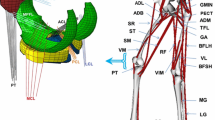Abstract
It is well known that the geometry of the articular surface has a major role in determining the position of articular contact and the lines of action for the contact forces. The contact force calculation of the knee joint under the effect of sliding and rolling is one of the most challenging issues in this field. We present a 3-D human knee joint model including sliding and rolling motions and major ligaments to calculate the lateral and medial condyle contact forces from the recovered total internal reaction force using inverse dynamic contact modeling and the Least-Square method. As results, it is believed that the patella, muscles and tendon affect a lot for the internal reaction forces at the initial heel contact stage. With increasing flexion angles during gait, the decreasing contact area is progressively shifted to the posterior direction on the tibia plateau. In addition, the medial side contact force is larger than the lateral side contact force in the knee joint during normal human walking. The total internal forces of the knee joint are reasonabe compared to previous studies.
Similar content being viewed by others
References
Abdel-Rahman, E. M. and Hefzy, M. S., 1998, “Three-Dimensional Dynamic Behavior of the Human Knee Joint under Impact Loading,”Medical Engng. & Physics, Vol. 20, pp. 276–290.
Allard, P., Stokes, I. A. F. and Blanchi, J.-P., 1995, Three-Dimensional Analysis of Human Movement, Human Kinetics, Champaign, Illinois.
Ateshian, G. A., Lai, W. M., Zhu, W. B. and Mow, V. C., 1994, “An Asymptotic Solution for the Contact of Two Biphasic Cartilage Layers,”J. Biomechanics, Vol. 27, pp. 1347–1360.
Attfield, S. F., Gleeson, N. P., Pickering, P. and Rees, D., 1998, “Evaluation of Dynamic Anterior Cruciate Ligaments Strain During Ambulation,”Gait & Posture, Vol. 7, pp. 154–155.
Bronzino, J. D., 1995, The Biomedical Engineering Handbook, Boca Raton; CRC Press; IEEE Press.
Brown, T. D. and Shaw, D. T., 1984, In-Vitro Contact Stress Distributions on the Femoral Condyles.J. orthopedic research society, Vol. 2, No. 2.
Bobbert, M. F., Schamhardt, H. C. and Nigg, B. M., 1991, “Calculation of Vertical Ground Reaction Force Estimates During Running from Position Data,”J. Biomechanics, Vol. 24, No. 12, pp. 1095–1105.
Eberhardt, A. W., Keer, L. M., Lewis, J. L. and Vithoontien, V., 1990, “An Analytical Model of Joint Contact,”J. Biomech. Engng., Vol. 112, pp. 407–413.
Eberhardt, A. W., Lewis, J. L. and Keer, L. M., 1991, “Contact of Layered Elastic Spheres as a Model of Joint Contact: Effect of Tangential Load and Friction,”J. Biomech. Engng., Vol. 113, pp. 107–108.
Grood, E. S. and Suntay, W. J., 1983, “A Joint Coordinate System for the Clinical Description of Three-Dimensional Motions: Application to the Knee,”Journal of Biomechanical Engineering, Vol. 105, pp. 136–144.
Iseki, F. and Tomatsu, T., 1976, “The Biomechanics of the Knee Joint with Special Reference to the Contact Area,”Keio J. Med. Vol. 25, pp. 37–44.
Kadaba, M. P., Ramakrishan, H. K. and Wootten, M. E., 1990, “Measurement of Lower Extremity Kinematics During Level Walking,”Journal of Orthopaedic Research Society, Vol. 8, No. 3, pp. 383–392.
Kapandji, I. A., 1970, The Physiology of the Joint: Volume Two Lower Lim, Churchill Livingston Inc., New York.
Koopman, B., Grootenboer, H. J. and Jongh, H. J. de, 1995, An Inverse Dynamic Model for the Analysis, Reconstruction and Prediction of Bipedal Walking, J. Biomechanics, Vol. 28, No. 11, pp. 1369–1376.
Mun, J. H., 2001, “A New Experimental Error Reduction Method for Three-Dimensional Human Motion Analysis,”Journal of Biomedical Engineering Research, Vol. 22, pp. 459–467.
Mun, J. H. and Takeuchi, S., 2002, “Three-Dimensional Kinematic Model of the Human Knee Joint During Gait,”Journal of Biomedical Engineering Research, Vol. 23, pp. 171–179.
Pandy, M. G. and Berme N., 1988, A Numerical Method for Simulating the Dynamics of Human Walking,J. Biomechanics, Vol. 21, No. 12, pp. 1043–1051.
Reinschmidt, C., Bobert, A. J. van den, Lundberg, A., Nigg, B. M., Murphy, N., Stacoff, A. and Stano, A., 1997, “Tibiofemoral and Tibiocalcaneal Motion During Walking: External vs. Skeletal Marker,”Gait and Posture, Vol. 6, pp. 98–109.
Wilson, D. R. and O’Connor, J. J., 1997, “A Three-Dimensional Geometric Model of the Knee for the Study of Joint Forces in Gait,”Gait & Posture, Vol. 5, pp. 108–115.
Wretenberg, P., Ramsey, D. K., Nemeth, G., 2002, “Tibiofemoral Contact Points Relative to Flexion Angle Measured with MRI,”Clinical Biomechanics, Vol. 17, pp. 477–485.
Zwick, E. B., Saraph, V., Zwick, G., Steinwender, C., Linhart, W. E. and Steinwender, G., 2002, “Medial Hamstring Lengthening in the Presence of Hip Flexor Tightness in Spastic Dipegia,”Gait & Posture, Vol. 16, pp. 288–296.
Author information
Authors and Affiliations
Corresponding author
Rights and permissions
About this article
Cite this article
Mun, J.H., Lee, DW. Three-dimensional contact dynamic model of the human knee joint during walking. KSME International Journal 18, 211–220 (2004). https://doi.org/10.1007/BF03184730
Received:
Revised:
Issue Date:
DOI: https://doi.org/10.1007/BF03184730




